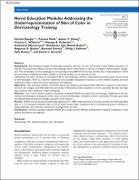| dc.contributor.author | Slaught, Christa | |
| dc.contributor.author | Madu, Pamela | |
| dc.contributor.author | Chang, Aileen Y. | |
| dc.contributor.author | Williams, Victoria L. | |
| dc.contributor.author | Kebaetse, Masego B. | |
| dc.contributor.author | Nkomazana, Oathokwa | |
| dc.contributor.author | Molefe-Baikai, Onkabetse Julia | |
| dc.contributor.author | Bekele, Negussie A. | |
| dc.contributor.author | Omech, Bernard | |
| dc.contributor.author | Kellman, Philip J. | |
| dc.contributor.author | Krasne, Sally | |
| dc.contributor.author | Kovarik, Carrie L. | |
| dc.date.accessioned | 2021-11-22T11:25:30Z | |
| dc.date.available | 2021-11-22T11:25:30Z | |
| dc.date.issued | 2021 | |
| dc.identifier.citation | Slaught, C., Madu, P., Chang, A. Y., Williams, V. L., Kebaetse, M. B., Nkomazana, O., ... & Kovarik, C. L. (2021). Novel Education Modules Addressing the Underrepresentation of Skin of Color in Dermatology Training. Journal of Cutaneous Medicine and Surgery, 12034754211035093. | en_US |
| dc.identifier.uri | DOI: 10. 1177/ 1203 4754 2110 35093 | |
| dc.identifier.uri | https://hdl.handle.net/123456789/345 | |
| dc.description.abstract | Background: Representative images of pathology in patients with skin of color are lacking in most medical education resources.
This particularly affects training in dermatology, which relies heavily on the use of images to teach pattern recognition.
The presentation of skin pathology can vary greatly among different skin tones, and this lack of representation of dark
skin phototypes challenges providers’ abilities to provide quality care to patients of color.
In Botswana and other countries in sub-Saharan
Africa, this challenge is further compounded by limited resources and access
to dermatologists. There is a need for improved and accessible educational resources to train medical students and local
medical providers in basic skin lesion description and diagnosis.
Objectives: We examined whether online Perceptual and Adaptive Learning Modules (PALMs) composed of representative
dark skin images could efficiently train University of Botswana medical students to more accurately describe and diagnose
common skin conditions in their community.
Methods: Year 4 and 5 medical students voluntarily completed PALMs that teach skin morphology, configuration, and distribution
terminology and diagnosis of the most common dermatologic conditions in their community. Pre-tests,
post-tests
and delayed-tests
assessed knowledge acquisition and retention.
Results: PALMs training produced statistically significant (P < .0001) improvements in accuracy and fluency with large effect
sizes (1.5, 3.7) and good retention after a 12.5-21-week
median delay. Limitations were a self-selected
group of students, a
single institution, slow internet connections, and high drop-out
rates.
Conclusions: Overall, population-specific
PALMs are a useful tool for efficient development of pattern recognition in skin
disease description and diagnosis. | en_US |
| dc.language.iso | en | en_US |
| dc.publisher | Journal of Cutaneous Medicine and Surgery | en_US |
| dc.subject | dermatology, HIV, infectious disease, acne, dermatitis | en_US |
| dc.title | Novel Education Modules Addressing the Underrepresentation of Skin of Color in Dermatology Training | en_US |
| dc.type | Article | en_US |

